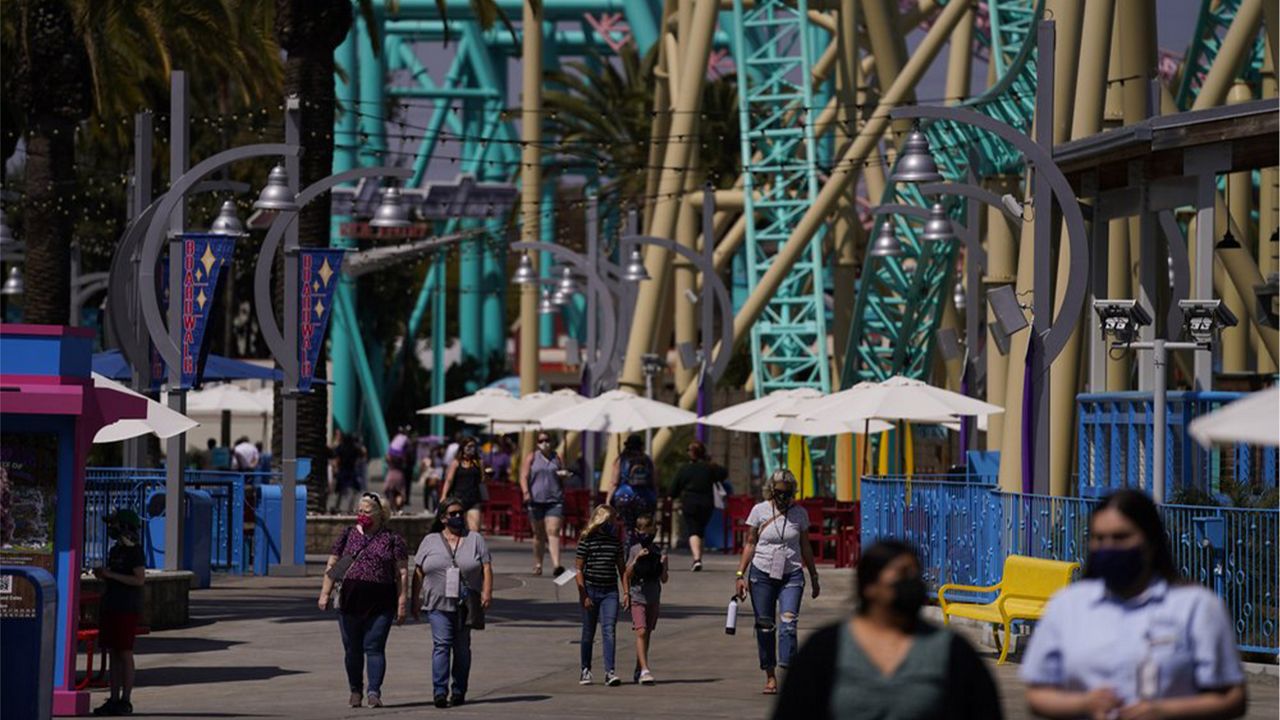LOS ANGELES (AP) — Nearly half of California’s 40 million people are living in areas where coronavirus restrictions are easing and some of the largest counties are preparing to expand movie theater and restaurant reopenings despite worries about a new surge and demand for limited vaccine supplies.
Massive Los Angeles County and neighboring Orange County dropped into orange, the state’s second-least restrictive of four color-coded tiers, according to a weekly state update Tuesday. They and 11 other counties moving into the less-stringent category — including Santa Cruz and Alameda — altogether have a population of around 17 million.
Officials in Orange County said that as of Wednesday restaurants, theaters, museums, and houses of worship can allow people indoors at 50% capacity. Bars that don’t serve food can operate outdoors, and bowling alleys and card rooms can operate indoors at 25% capacity.
The county has about 3 million residents.
It was joyful news for Orange County Brewers Guild President Wil Dee.
“We’re able to do what we are in business to do,” he told the Orange County Register. “If I want to eat, I’ll go to a restaurant; if I want a beer, I’ll go to a brewery.”
Lucy Dunn, chief executive officer of the Orange County Business Council, attributed the changes to people following public health guidelines.
“I’m thrilled,” she told the Register. “Folks have taken the vaccinations seriously, good health protocols seriously — our numbers are reflective of that.”
However L.A. County, with about 10 million residents, was taking a more cautious approach and won’t loosen its restrictions until next Monday. That allows a three-week gap to ensure that the number of COVID-19 cases doesn’t rise in the wake of a previous relaxation of some rules on March 15 and given the mix of new virus variants, public health officials announced.
“Remember, this still is a virus that has a very long incubation period, so this week becomes critical,” public health director Dr. Barbara Ferrer said.
At the peak of a winter surge, the county saw well over 10,000 new cases and more than 200 deaths a day but infections, hospitalizations and deaths have been dropping. On Tuesday, the average daily rate of new infections was below 400 — a 50% decrease from the end of February.
San Diego County, the state’s second-most populous with about 3.5 million people, isn’t expected to move into the orange tier for at least another week. Seventeen counties sit in the orange, or “moderate,” tier and two counties were in the least-restricted yellow tier.
Statewide, only three counties totaling more than 1 million people — San Joaquin, Merced and Inyo — remain in the state’s most restricted purple tier, where the virus remains widespread. Thirty-six counties are in the red tier, including hard-hit Fresno County, where officials said Tuesday people could dine indoors and visit the movies and museums at 25% capacity starting Wednesday.
Still, health officials are urging caution. California, which has taken a careful approach to reopening businesses, has one of the lowest infection rates in the country even as caseloads rise in many other states.
Rochelle Walensky, director of the U.S. Centers for Disease Control and Prevention, spoke of her feeling of “impending doom” on Monday if some states keep easing mask-wearing and other restrictions.
L.A. County’s Ferrer implored people there to continue wearing masks.
“If we wish to maintain these low numbers, it will be essential that each of us not get sloppy,” she said.
Health officials see widespread vaccinations as the key to defeating the year-long coronavirus pandemic.
“It’s going to be almost a race between getting people vaccinated, versus avoiding a surge of new cases,” Dr. Anthony Fauci, director of the National Institute of Allergy and Infectious Diseases, said Tuesday.
California has administered more than 17.6 million doses of vaccine and more than 6 million people have been fully inoculated by receiving a second dose.
Statewide, eligibility had been limited to those 65 and older and people with certain medical conditions, considered the most vulnerable populations for COVID-19 and the most likely to suffer serious medical issues.
However, eligibility is expanding to people 50 and older starting Thursday and to all adults on April 15, which could make it harder for people to get appointments even as supply increases.
Some regions are moving more quickly than others to expand eligibility.
The San Francisco Bay Area county of Contra Costa announced Tuesday that vaccines are available for residents 16 and older, saying it has thousands of vaccine appointments available at its community clinics this week because of increased supply from the state and federal governments. The county has about 1.2 million people.



